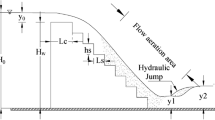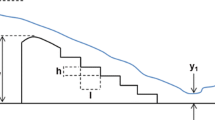Abstract
Stepped spillway is an effective approach to remove the potential occurrences of cavitation in chute of spillways and also to significantly reduce the size of energy dissipators at the toe of dam. In this study, to predict the energy dissipation ratio of flow over stepped spillways, artificial neural network, support vector machine, genetic programming (GP), group method of data handling (GMDH), and multivariate adaptive regression splines (MARS) were developed. MARS, GMDH, and GP are smart function fitting methods that assign more weight to the most effective parameters on the output. These models, in addition to predicting the desired phenomena, present a mathematical expression between independent and dependent variables. Results of applied models indicated that all models have suitable performance; however, MARS model with coefficient of determination close to 0.99 in training and testing stages is more accurate compared to others. This model also has a high ability to present the mathematical expression between involved parameters in energy dissipation. To derive the most influential parameters on efficiency of stepped spillways in terms of energy dissipation of flow, a review on the structure of models derived from GP, GMDH, and MARS was carried out. Results indicated that drop number, ratio of critical depth to the height of steps, and Froude number are the most effective parameters on energy dissipation of flow over stepped spillways.













Similar content being viewed by others
Explore related subjects
Discover the latest articles and news from researchers in related subjects, suggested using machine learning.Abbreviations
- ANFIS:
-
Adaptive neuro-fuzzy inference system
- ANN:
-
Artificial neural network
- AVEG:
-
Average
- bi:
-
Bias
- DN:
-
Drop number
- E :
-
Specific energy
- EDR:
-
Energy dissipation ratio
- Fr :
-
Froude number
- g :
-
Gravity acceleration
- GA:
-
Genetic algorithm
- GEP:
-
Gene expression programming
- GMDH:
-
Group method of data handling
- GP:
-
Genetic programming
- h :
-
Height of steps
- H w :
-
Dam height
- l :
-
Length of steps
- LM:
-
Least square
- MARS:
-
Multivariate adaptive regression splines
- Max:
-
Maximum
- Min:
-
Minimum
- MLP:
-
Multilayer perceptron neural networks
- PSO:
-
Partcle swarm optimization
- RBF:
-
Radial basis function
- S :
-
Slope of stepped spillway
- STDEV:
-
Standard deviation
- SVM:
-
Support vector machine
- V :
-
Flow velocity
- wi:
-
Weight
- y :
-
Flow depth
- Y c/h :
-
Critical depth to the height of steps
- C :
-
Error penalty factor
- w :
-
Normal vector
- ε :
-
Loss function
References
Attarian A, Hosseini K, Abdi H, Hosseini M (2014) The effect of the step height on energy dissipation in stepped spillways using numerical simulation. Arab J Sci Eng 39:2587–2594. doi:10.1007/s13369-013-0900-y
Azamathulla HM (2013) A review on application of soft computing methods in water resources engineering. In: Gandomi AH, Talatahari S, Alavi AH (eds) Metaheuristics in water, geotechnical and transport engineering. Elsevier, Oxford, pp 27–41
Azamathulla H, Ghani A (2011) Genetic programming for predicting longitudinal dispersion coefficients in streams. Water Resour Manag 25:1537–1544. doi:10.1007/s11269-010-9759-9
Azamathulla HM, Mohd. Yusoff MA (2013) Soft computing for prediction of river pipeline scour depth. Neural Comput Appl 23:2465–2469. doi:10.1007/s00521-012-1205-x
Azamathulla HM, Wu F-C (2011) Support vector machine approach for longitudinal dispersion coefficients in natural streams. Appl Soft Comput 11:2902–2905. doi:10.1016/j.asoc.2010.11.026
Azamathulla H, Ghani A, Zakaria NA, Lai SH, Chang CK, Leow CS, Abuhasan Z (2008) Genetic programming to predict ski-jump bucket spill-way scour. J Hydrodyn Ser B 20:477–484. doi:10.1016/S1001-6058(08)60083-9
Azamathulla HM, Ghani AA, Zakaria NA, Guven A (2010) Genetic programming to predict bridge pier scour. J Hydraul Eng 136:165–169. doi:10.1061/(ASCE)HY.1943-7900.0000133
Azamathulla HM, Haghiabi AH, Parsaie A (2016) Prediction of side weir discharge coefficient by support vector machine technique. Water Sci Technol Water Supply. doi:10.2166/ws.2016.014
Boes RM et al (2000) Characteristics of skimming flow over stepped spillways. J Hydraul Eng 126:860–873. doi:10.1061/(asce)0733-9429(2000)126:11(860)
Chanson H (2002) Hydraulics of stepped chutes and spillways. Taylor & Francis, London
Chatila JG, Jurdi BR (2004) Stepped spillway as an energy dissipater. Can Water Resour 29:147–158. doi:10.4296/cwrj147
Chen SH (2015) Hydraulic structures. Springer, Berlin
Cheng X, Chen Y, Luo L (2006) Numerical simulation of air–water two-phase flow over stepped spillways. Sci China Ser E: Technol Sci 49:674–684. doi:10.1007/s10288-006-2029-2
Dehdar-behbahani S, Parsaie A (2016) Numerical modeling of flow pattern in dam spillway’s guide wall. Case study: Balaroud dam, Iran. Alex Eng J 55:467–473. doi:10.1016/j.aej.2016.01.006
Emamgholizadeh S, Kashi H, Marofpoor I, Zalaghi E (2014a) Prediction of water quality parameters of Karoon River (Iran) by artificial intelligence-based models. Int J Environ Sci Technol 11:645–656. doi:10.1007/s13762-013-0378-x
Emamgholizadeh S, Moslemi K, Karami G (2014b) Prediction the groundwater level of Bastam Plain (Iran) by artificial neural network (ANN) and adaptive neuro-fuzzy inference system (ANFIS). Water Resour Manag 28:5433–5446. doi:10.1007/s11269-014-0810-0
Emamgholizadeh S, Bahman K, Bateni SM, Ghorbani H, Marofpoor I, Nielson JR (2016) Estimation of soil dispersivity using soft computing approaches. Neural Comput Appl. doi:10.1007/s00521-016-2320-x
Emamgolizadeh S, Bateni SM, Shahsavani D, Ashrafi T, Ghorbani H (2015) Estimation of soil cation exchange capacity using genetic expression programming (GEP) and multivariate adaptive regression splines (MARS). J Hydrol 529(3):1590–1600. doi:10.1016/j.jhydrol.2015.08.025
Felder S, Chanson H (2011) Energy dissipation down a stepped spillway with nonuniform step heights. J Hydraul Eng 137:1543–1548. doi:10.1061/(asce)hy.1943-7900.0000455
Fen N, Kozlov DB, Rumyantsev IS (2016) Hydraulic studies of stepped spillways of various design. Power Technol Eng 49:337–344. doi:10.1007/s10749-016-0625-7
Friedman JH (1991) Multivariate adaptive regression splines. The annals of statistics 1-67
Frizell KW, Renna FM, Matos J (2013) Cavitation potential of flow on stepped spillways. J Hydraul Eng 139:630–636. doi:10.1061/(asce)hy.1943-7900.0000715
Guven A, Kişi Ö (2011) Estimation of suspended sediment yield in natural rivers using machine-coded linear genetic programming. Water Resour Manag 25:691–704. doi:10.1007/s11269-010-9721-x
Haghiabi AH (2016) Prediction of longitudinal dispersion coefficient using multivariate adaptive regression splines. J Earth Syst Sci. doi:10.1007/s12040-016-0708-8
Husain SM, Muhammed JR, Karunarathna HU, Reeve DE (2014) Investigation of pressure variations over stepped spillways using smooth particle hydrodynamics. Adv Water Resour 66:52–69. doi:10.1016/j.advwatres.2013.11.013
Ivakhnenko AG (1971) Polynomial theory of complex systems. IEEE Trans Syst Man Cybern SMC 1:364–378. doi:10.1109/TSMC.1971.4308320
Karbasi M, Azamathulla HM (2016) Prediction of scour caused by 2D horizontal jets using soft computing techniques. Ain Shams Eng J. doi:10.1016/j.asej.2016.04.001
Mohammad Rezapour Tabari M, Tavakoli S (2016) Effects of stepped spillway geometry on flow pattern and energy dissipation. Arab J Sci Eng 41:1215–1224. doi:10.1007/s13369-015-1874-8
Morovati K, Eghbalzadeh A, Javan M (2016) Numerical investigation of the configuration of the pools on the flow pattern passing over pooled stepped spillway in skimming flow regime. Acta Mech 227:353–366. doi:10.1007/s00707-015-1444-x
Najafzadeh M (2016) Neurofuzzy-based GMDH-PSO to predict maximum scour depth at equilibrium at culvert outlets. J Pipeline Syst Eng Pract 7:06015001. doi:10.1061/(ASCE)PS.1949-1204.0000204
Najafzadeh M, Azamathulla HM (2015) Neuro-fuzzy GMDH to predict the scour pile groups due to waves. J Comput Civ Eng 29:04014068. doi:10.1061/(ASCE)CP.1943-5487.0000376
Najafzadeh M, Barani GA (2011) Comparison of group method of data handling based genetic programming and back propagation systems to predict scour depth around bridge piers. Sci Iran 18:1207–1213. doi:10.1016/j.scient.2011.11.017
Najafzadeh M, Bonakdari H (2016) Application of a neuro-fuzzy GMDH model for predicting the velocity at limit of deposition in storm sewers. J Pipeline Syst Eng Pract. doi:10.1061/(asce)ps.1949-1204.0000249
Najafzadeh M, Sattar AA (2015) Neuro-fuzzy GMDH approach to predict longitudinal dispersion in water networks. Water Resour Manag 29:2205–2219. doi:10.1007/s11269-015-0936-8
Najafzadeh M, Tafarojnoruz A (2016) Evaluation of neuro-fuzzy GMDH-based particle swarm optimization to predict longitudinal dispersion coefficient in rivers. Environ Earth Sci 75:1–12. doi:10.1007/s12665-015-4877-6
Najafzadeh M, Zahiri A (2015) Neuro-fuzzy GMDH-based evolutionary algorithms to predict flow discharge in straight compound channels. J Hydrol Eng 20:04015035. doi:10.1061/(asce)he.1943-5584.0001185
Najafzadeh M, Etemad-Shahidi A, Lim SY (2016) Scour prediction in long contractions using ANFIS and SVM. Ocean Eng 111:128–135. doi:10.1016/j.oceaneng.2015.10.053
Nikseresht AH, Talebbeydokhti N, Rezaei MJ (2013) Numerical simulation of two-phase flow on step-pool spillways. Sci Iran 20:222–230. doi:10.1016/j.scient.2012.11.013
Noori R, Karbassi A, Farokhnia A, Dehghani M (2009) Predicting the longitudinal dispersion coefficient using support vector machine and adaptive neuro-fuzzy inference system techniques. Environ Eng Sci 26:1503–1510. doi:10.1089/ees.2008.0360
Noori R, Karbassi A, Salman Sabahi M (2010a) Evaluation of PCA and Gamma test techniques on ANN operation for weekly solid waste prediction. J Environ Manag 91:767–771. doi:10.1016/j.jenvman.2009.10.007
Noori R, Khakpour A, Omidvar B, Farokhnia A (2010b) Comparison of ANN and principal component analysis-multivariate linear regression models for predicting the river flow based on developed discrepancy ratio statistic. Expert Syst Appl 37:5856–5862. doi:10.1016/j.eswa.2010.02.020
Noori R, Yeh H-D, Abbasi M, Kachoosangi FT, Moazami S (2015) Uncertainty analysis of support vector machine for online prediction of five-day biochemical oxygen demand. J Hydrol 527:833–843. doi:10.1016/j.jhydrol.2015.05.046
Parsaie A, Haghiabi A (2015a) The effect of predicting discharge coefficient by neural network on increasing the numerical modeling accuracy of flow over side weir. Water Resour Manag 29:973–985. doi:10.1007/s11269-014-0827-4
Parsaie A, Haghiabi AH (2015b) Computational modeling of pollution transmission in rivers. Appl Water Sci. doi:10.1007/s13201-015-0319-6
Parsaie A, Haghiabi AH, Moradinejad A (2015) CFD modeling of flow pattern in spillway’s approach channel. Sustain Water Resour Manag 1(3):245–251. doi:10.1007/s40899-015-0020-9
Parsaie A, Haghiabi AH, Saneie M, Torabi H (2016) Applications of soft computing techniques for prediction of energy dissipation on stepped spillways. Neural Comput Appl 1–17. doi:10.1007/s00521-016-2667-z
Pfister M, Hager WH (2011) Self-entrainment of air on stepped spillways. Int J Multiph Flow 37:99–107. doi:10.1016/j.ijmultiphaseflow.2010.10.007
Roushangar K, Akhgar S, Salmasi F, Shiri J (2014) Modeling energy dissipation over stepped spillways using machine learning approaches. J Hydrol 508:254–265. doi:10.1016/j.jhydrol.2013.10.053
Salmasi F, Özger M (2014) Neuro-fuzzy approach for estimating energy dissipation in skimming flow over stepped spillways. Arab J Sci Eng 39:6099–6108. doi:10.1007/s13369-014-1240-2
Samadi M, Jabbari E, Azamathulla HM, Mojallal M (2015) Estimation of scour depth below free overfall spillways using multivariate adaptive regression splines and artificial neural networks. Eng Appl Comput Fluid Mech 9(1):291–300. doi:10.1080/19942060.2015.1011826
Sattar AMA, Gharabaghi B (2015) Gene expression models for prediction of longitudinal dispersion coefficient in streams. J Hydrol 524:587–596. doi:10.1016/j.jhydrol.2015.03.016
Sorensen RM (1985) Stepped spillway hydraulic model investigation. J Hydraul Eng 111:1461–1472. doi:10.1061/(asce)0733-9429(1985)111:12(1461)
Tabbara M, Chatila J, Awwad R (2005) Computational simulation of flow over stepped spillways. Comput Struct 83:2215–2224. doi:10.1016/j.compstruc.2005.04.005
Tatewar SP, Ingle RN (1996) Energy dissipation in skimming flow over stepped spillways ish. J Hydraul Eng 2:45–51. doi:10.1080/09715010.1996.10514591
Zahiri A, Azamathulla HM (2014) Comparison between linear genetic programming and M5 tree models to predict flow discharge in compound channels. Neural Comput Appl 24:413–420. doi:10.1007/s00521-012-1247-0
Zare HK, Doering JC (2012) Energy dissipation and flow characteristics of baffles and sills on stepped spillways. J Hydraul Res 50:192–199. doi:10.1080/00221686.2012.659840
Zhan J, Zhang J, Gong Y (2016) Numerical investigation of air-entrainment in skimming flow over stepped spillways. Theor Appl Mech Lett 6:139–142. doi:10.1016/j.taml.2016.03.003
Author information
Authors and Affiliations
Corresponding author
Rights and permissions
About this article
Cite this article
Parsaie, A., Haghiabi, A.H., Saneie, M. et al. Prediction of Energy Dissipation of Flow Over Stepped Spillways Using Data-Driven Models. Iran J Sci Technol Trans Civ Eng 42, 39–53 (2018). https://doi.org/10.1007/s40996-017-0060-5
Received:
Accepted:
Published:
Issue Date:
DOI: https://doi.org/10.1007/s40996-017-0060-5




